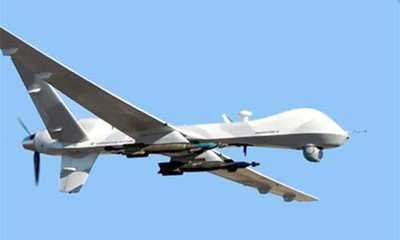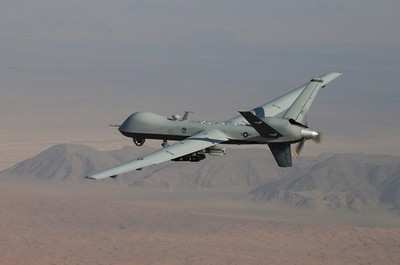Mon, Nov 01, 2010
First Flight Of A Penetrating Synthetic Aperture Radar On A
Fixed Wing UAS
A Predator B MQ-9 UAS has been flown for the first time using
Lockheed Martin's Tactical Reconnaissance and
Counter-Concealment-Enabled Radar (TRACER). The flight also
marks the first time a penetrating radar has flown on a fixed wing
unmanned aerial system. TRACER, a dual-band synthetic-aperture
radar (SAR), detects vehicles, buildings and other man-made objects
that are buried, camouflaged or concealed under foliage in
real-time. Flight testing and system validation will continue in
multiple environments.

MQ-9 File Photo
TRACER's design is predicated on Lockheed Martin's foliage
penetration (FOPEN) technology, which incorporates dual-band
synthetic aperture radar, and provides high resolution images to
ground units in all-weather, day or night conditions, as well as
operating in various collection modes. TRACER has already
successfully completed approximately one hundred test flights on
manned platforms.
"This demonstrates the maturity of penetrating SAR and that
TRACER is clearly deployment ready," said Jim Quinn, vice president
with Lockheed Martin's Information Systems & Global
Solutions-Defense. "When deployed, this "hunting" sensor can use
the penetrating RADAR capability to provide ground commanders with
intelligence not available from a traditional optical sensor."

File Photo
The purpose of these test flights is to demonstrate the ability
to operate the radar remotely utilizing a high endurance platform.
The TRACER configuration aboard the MQ-9 also utilizes an external
unpressurized pod to house the RF portion of the system. The tests
aboard a NASA-operated Predator B (Ikhana) unmanned aircraft is
underway. During the flight testing, the system will collect
high resolution SAR imagery. The Ikhana performed as a surrogate
for the Army's "Gray Eagle" (MQ-1) unmanned aerial system, which
was not available because of current mission critical needs. The
flight tests on the Ikhana focused on the radar's performance in
the harsh environment of the unpressurized pod, and are intended to
mitigate risk for eventual installation on the Army UAS.
The company says TRACER is unique in that it will provide the
Army with tactical penetrating radar that is deployable on both
manned and unmanned platforms in a variety of environments. The
dual band capability of TRACER increases target detection over a
variety of terrain and concealment scenarios. TRACER also
incorporates data link technology that allows airborne processed
results to be down-linked to ground stations immediately. The
system includes a portable ground station to plan, collect, support
missions, and exploit imagery.
More News
Aero Linx: Aviators Code Initiative (ACI) Innovative tools advancing aviation safety and offering a vision of excellence for aviators. The ACI materials are for use by aviation pra>[...]
Make Sure You NEVER Miss A New Story From Aero-News Network Do you ever feel like you never see posts from a certain person or page on Facebook or Instagram? Here’s how you c>[...]
From 2016 (YouTube Edition): Who You Gonna Call When You Have a Rocket Engine that Needs a Spacecraft? While at EAA AirVenture 2016, ANN CEO and Editor-In-Chief, Jim Campbell, sat >[...]
"In my opinion, if this isn't an excessive fine, I don't know what is... The odds are good that we're gonna be seeking review in the United States Supreme Court. So we gotta muster>[...]
Expedite Used by ATC when prompt compliance is required to avoid the development of an imminent situation. Expedite climb/descent normally indicates to a pilot that the approximate>[...]
 ANN's Daily Aero-Linx (04.30.25)
ANN's Daily Aero-Linx (04.30.25) ANN FAQ: Turn On Post Notifications
ANN FAQ: Turn On Post Notifications Classic Aero-TV: Agile Aeros Jeff Greason--Disruptive Aerospace Innovations
Classic Aero-TV: Agile Aeros Jeff Greason--Disruptive Aerospace Innovations Aero-News: Quote of the Day (04.30.25)
Aero-News: Quote of the Day (04.30.25) ANN's Daily Aero-Term (04.30.25): Expedite
ANN's Daily Aero-Term (04.30.25): Expedite




